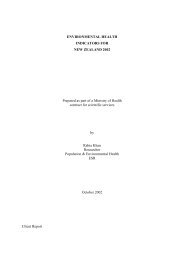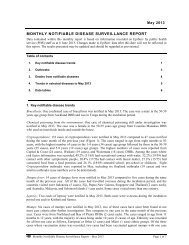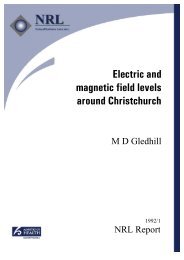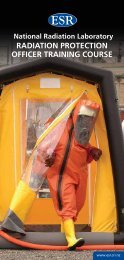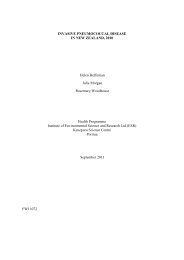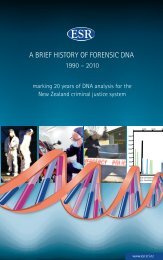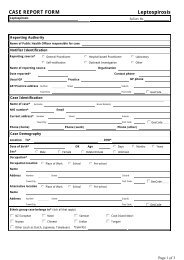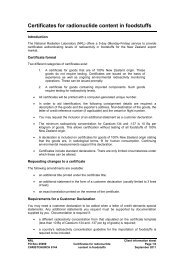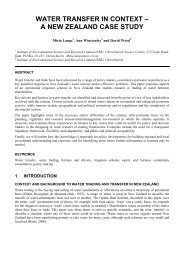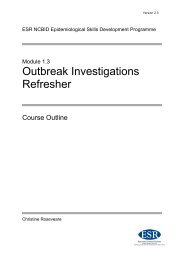Rongoa Maori Summary Report - Environmental Science & Research
Rongoa Maori Summary Report - Environmental Science & Research
Rongoa Maori Summary Report - Environmental Science & Research
You also want an ePaper? Increase the reach of your titles
YUMPU automatically turns print PDFs into web optimized ePapers that Google loves.
The Future of<br />
<strong>Rongoa</strong> <strong>Maori</strong><br />
Wellbeing and Sustainability<br />
<strong>Summary</strong><br />
October 2008<br />
www.esr.cri.nz
1 The future of rongoa <strong>Maori</strong>
THE FUTURE OF RONGO MORI: WELLBEING AND<br />
SUSTAINABILITY<br />
A SUMMARY<br />
INSTITUTE OF ENVIRONMENTAL SCIENCE AND RESEARCH LTD.<br />
Annabel Ahuriri-Driscoll<br />
Virginia Baker<br />
Maria Hepi<br />
Maui Hudson<br />
TE WHARE WNANGA O AWANUIRANGI<br />
Carl Mika<br />
Sarah-Jane Tiakiwai<br />
in partnership with<br />
NG RINGA WHAKAHAERE O TE IWI MORI<br />
Client <strong>Report</strong><br />
FW06113<br />
2<br />
The future of rongoa <strong>Maori</strong><br />
2
3 The future of rongoa <strong>Maori</strong>
Introduction<br />
Around 80% of the developing world’s rural population depends on traditional medicines for its primary<br />
healthcare needs (World Health Organization (WHO) 2003). Since the late 1970s, the WHO has promoted<br />
traditional medicines internationally. Now the popularity of traditional medicines is increasing, and their<br />
use is spreading among urban populations in many industrialised countries.<br />
The growth in interest in, and utilisation of, traditional medicine and healing practices has led to varying<br />
degrees of integration with the dominant westernised approach to medicine. However, scepticism remains<br />
among indigenous peoples about whether successful integration and acceptance within modern health<br />
systems is possible.<br />
In New Zealand, traditional healing has a long history of usage and credibility among Mori. Recently, a<br />
research project was completed that looked into the current status of traditional Mori healing and its<br />
contribution to wellbeing, and the integration of rongo Mori with mainstream healthcare to sustain the<br />
practice. A Mori research/inquiry paradigm guided the research. The project was informed by a national<br />
literature review, and focus groups and workshops with traditional healers and rongo Mori stakeholders.<br />
This work provided direction about the research required to support the integration of rongo Mori with<br />
mainstream healthcare.<br />
This report summarises the findings of the research project and is based on the report ‘The future of rongo<br />
Mori: wellbeing and sustainability’, prepared for Te Kete Hauora (Ministry of Health) by the Institute of<br />
<strong>Environmental</strong> <strong>Science</strong> and <strong>Research</strong> (ESR) Ltd. and Te Whare Wnanga o Awanuirangi, in partnership<br />
with Ng Ringa Whakahaere o te Iwi Mori.<br />
4<br />
The future of rongoa <strong>Maori</strong><br />
4
Rongo Mori scope and practice<br />
Rongo Mori or traditional Mori healing has developed out of Mori cultural traditions. It is a holistic<br />
system of healing comprising a range of diagnostic and treatment modalities, reflecting an approach to<br />
health that embodies wairuatanga (spirituality) as part of ‘the whole’, alongside physical, mental and social<br />
aspects of health. The literature describes rongo Mori as a locally specific tradition, with bounds beyond<br />
that of a herbal health practice.<br />
A broad range of healing practices is included within rongo Mori – all are underpinned by a Mori<br />
worldview and conceptualisation of wellbeing (Durie et al., 1993). Several modalities are identified,<br />
including ritenga and karakia (incantations and rituals involved with healing), rongo (physical remedies<br />
derived from trees, leaves, berries, fruits, bark and moss), mirimiri (similar to massage/physiotherapy),<br />
wai (use of water to heal), and surgical interventions. Healers do not practice uniformly, and considerable<br />
diversity exists in the application of particular modalities (Durie et al., 1993). Jones (2000a) relates this to<br />
cultural tradition and a long history of oral transmission of knowledge, leading to a specificity of traditional<br />
healing methods employed by Mori that vary according to region, iwi, hap and whnau.<br />
Sustainability issues and rongo<br />
Sustainable development applies to rongo Mori in two primary ways: sustainability in terms of<br />
environmental resources supplying the rongo (environmental wellbeing), and sustainability of the practice<br />
of rongo Mori, encompassing knowledge retention, validation of the practice and its utilisation (cultural<br />
and social wellbeing). Economic wellbeing, although not often emphasised in considerations of rongo<br />
Mori, is central to enabling healers to sustain their practice. These four pillars of sustainability form the<br />
basis of considerations for the future of rongo Mori.<br />
Impact of the changing environment on healing<br />
<strong>Environmental</strong> resources supplying the rongo are being degraded by chemicals, pests and changes in land<br />
use. Healers were disturbed by the appearance of 1080 during rongo preparations and also voiced<br />
concerns about the destruction to rongo as a result of aerial spraying. They cited the potential for rahui in<br />
these situations, in a bid to halt chemical applications. Workshop attendees also referred to the devastation<br />
to rongo caused by possums and other pests. They feared that soon there would be no rongo left to<br />
collect. Participants noted that rongo is becoming harder to obtain, requiring them to travel further<br />
distances to access and harvest suitable rkau. Participants in some stakeholder workshops also noted the<br />
difficulties in accessing plentiful, healthy rkau, due to loss of land, deforestation and increasing pollution:<br />
“the areas you can collect rongo are fewer and fewer, and the population is growing”. As another<br />
respondent stated: “it’s not just about the people, it’s about Papatnuku, the ngahere, it’s all sick”.<br />
Sustainability of traditional healing practice<br />
Sustainability of the practice of rongo Mori relates to knowledge retention and utilisation. Participants at<br />
the workshops mentioned the difficulties that practitioners face, particularly those who are called on<br />
frequently and are therefore overworked, or those who are simply ageing. Healers talked about struggles<br />
within their practice, in terms of dealing with considerable workloads, having to fulfill hefty administrative<br />
requirements and shouldering the responsibility of transmitting their knowledge to emerging healers.<br />
During the healers’ workshops it was noted that there is limited opportunity for training or side-by-side<br />
learning. Healers saw this as a risk to traditional healing knowledge in two respects; potentially limiting the<br />
transfer of information by those who possess the knowledge before they pass on, and subsequently losing<br />
some of the depth of mtauranga and tikanga Mori associated with rongo. Retaining this mtauranga was<br />
seen as essential for maintaining an effective practice. The need to uphold and protect cultural and<br />
intellectual property rights associated with rongo plants, knowledge, traditions and practice was noted by<br />
both healers and stakeholders.<br />
5<br />
5 The future of rongoa <strong>Maori</strong>
Current status of rongo Mori<br />
Rongo Mori has been in use from pre-European colonisation through to the current time. Over the last<br />
two decades there has been an encouraging revival in interest in traditional Mori healing, prompting calls<br />
for the practice to be formalised within the New Zealand public health system (Jones, 2000a).<br />
Rongo Mori infrastructure, funding and policy development<br />
Following the development of a framework for purchasing traditional healing services (Durie, 1996), and<br />
production of Mori traditional healing standards (Ministry of Health (MoH), 1999), the Health Funding<br />
Authority funded 10 new services more substantially (MoH, 2006). Funding for rongo Mori has steadily<br />
increased and currently, the MoH administers 16 rongo Mori contracts with providers throughout the<br />
country, of which a small number (3) have also been funded intermittently by the Accident Rehabilitation<br />
Compensation Insurance Company (ACC) to deliver accident treatment and rehabilitation services. It is<br />
worth noting that several contracted rongo Mori providers deliver services as part of primary health care.<br />
The Clinical Training Agency (CTA) funds a rongo Mori training programme to support practicing and<br />
emerging healers; this is delivered through Te Wnanga o Raukawa. Through this funding, traditional<br />
Mori healing occupies a legitimate, albeit marginal position in the New Zealand health system. Short<br />
descriptions of rongo Mori organisations, policy documents and support mechanisms are provided next.<br />
Ng Ringa Whakahaere<br />
Ng Ringa Whakahaere o te Iwi Mori (Network of Mori Traditional Healers) was established in 1993.<br />
Ng Ringa Whakahaere advocates on behalf of affiliated members and for more formal recognition of<br />
traditional healing practices. The network has also formulated accreditation procedures for healers and<br />
contributed to the national traditional healing service standards (Durie, 1996; MoH, 1999).<br />
‘Taonga Tuku Iho: treasures of our heritage’<br />
This plan (MoH, 2006) aligns rongo Mori development with the Mori health strategy, He Korowai<br />
Oranga (MoH, 2002a) through its overall aim of whnau ora and its key threads of rangatiratanga, building<br />
on gains and reducing inequalities. Through Whakattaka, the Mori Health Action Plan 2002–2005 (MoH,<br />
2002b), the actions to progress He Korowai Oranga are outlined, and within them, traditional healing is<br />
specifically noted as needing to be recognised and valued by the health and disability sector, alongside<br />
Mori models of health.<br />
‘Taonga Tuku Iho’ outlines a framework for strengthening the provision of quality rongo Mori services<br />
throughout the country in four main areas: improving the quality of rongo Mori services; creating<br />
leadership to strengthen safe practice through networking and quality assurance; increasing the capacity<br />
and capability of rongo Mori services; and constructing a workplan for research and evaluation activities<br />
(MoH, 2006).<br />
Te Paepae Matua m te Rongo<br />
Te Paepae Matua m te Rongo (Rongo Taumata) is a newly established entity whose purpose is to<br />
protect, nurture and grow rongo Mori. The Paepae Matua is made up of representatives of contracted<br />
clinics and will be supported by the Paepae Whenua (regional representative structure) and the Paepae<br />
Mahi (secretariat). While its development has been supported by the MoH, it is developing an operational<br />
model that maintains some independence from the Crown. It is envisaged that the kaumtua on the taumata,<br />
as ‘keepers of the knowledge’, will provide advice, help maintain the integrity of rongo Mori, protect<br />
rongo Mori now and for future mokopuna, and protect the mana of the taumata.<br />
6<br />
The future of rongoa <strong>Maori</strong><br />
6
Contribution of traditional healing to wellbeing<br />
Traditional Mori healing contributes to Mori wellbeing and development through<br />
The health benefits that its range of diagnostic and treatment modalities offer clients/patients, and<br />
employment and vocational opportunities associated with rongo Mori service development, and<br />
The empowerment and strength that retention and revitalisation of mtauranga, tikanga and te reo<br />
Mori can bring for Mori people.<br />
Health benefits<br />
Like other forms of traditional healing, rongo Mori has a long history of beneficial utilisation. Efficacy<br />
has been determined through practice based evidence rather than evaluation in controlled research settings.<br />
Indeed, the continued existence of particular treatments used to alleviate specific health conditions<br />
illustrates efficacy to some extent – based on the assumption that ineffective therapies would not be<br />
retained. Knowledge about rongo Mori and its health benefits passes from one generation to the next,<br />
rather than being documented formally (Cram et al., 2003). Rongo Mori practitioners wish to see rongo<br />
Mori acknowledged as a genuine form of medicine, due to the tangible benefits provided to many who use<br />
it (McGowan, 2000). Patient satisfaction is considered by many traditional healers to be the only real<br />
validation required (Jones, 2000a).<br />
Workshop participants were clear that the various rongo Mori modalities, including wairkau,<br />
counselling, wai, mirimiri, and krero whakapapa all facilitate healing. Some healers believed that simply<br />
attending to the needs of community members results in wellbeing, maintaining that their spiritual<br />
knowledge is of great benefit to the community. Another healer, a proponent of hauwai, a particular form<br />
of healing, claimed that this modality is suitable for pain relief, often used with people who have cancer.<br />
The contribution of rongo Mori to wellbeing was noted frequently in stakeholder workshops, although it<br />
was also an implicitly assumed starting point in the discussion of efforts and strategies to sustain rongo<br />
Mori and integrate traditional healing within publicly funded health services.<br />
Demand and utilisation<br />
Evidence of demand for traditional healing has formed the basis of a rationale for publicly funded rongo<br />
services (Durie, 1996). Jones (2000b) refers to use of rongo Mori at levels exceeding the expectations<br />
and awareness of mainstream health professionals. The reported increase in demand is based on anecdotal<br />
information however, and has not been validated formally with empirical data (Jones, 2000a). There<br />
remains uncertainty about the extent to which traditional Mori healing is practiced and utilised at a<br />
national level.<br />
Mori are motivated to use traditional healing because of limited access to and appropriateness of<br />
mainstream and primary health care services (Durie et al., 1993; NACCHDSS, 1995). A growing<br />
disillusionment with biomedical methods in treating ‘lifestyle’ illness/conditions, and the perceived<br />
strength of rongo Mori to address broader cultural, psychosocial and spiritual dimensions of health and<br />
illness have also contributed to increased uptake of these services by Mori (Durie, et al., 1993; Jones,<br />
2000a).<br />
During the workshops, demand for rongo Mori was discussed in terms of healers’ workloads –<br />
particularly those practitioners who are called on frequently. As one participant said, “tohunga and<br />
matakite get worn out – the demand is increasing “. Healers reported demand often outstripping<br />
availability, with the more successful practitioners being referred to constantly. Often, for instance, where<br />
hospitals are not servicing people well, these same people turn to alternatives such as rongo. Another<br />
healer remarked that, “when I go down to Murihiku I’m the only healer there. I go down to do 6 people and<br />
end up doing 60”.<br />
7<br />
7 The future of rongoa <strong>Maori</strong>
Employment and vocational opportunities<br />
A survey commissioned by Te Kete Hauora in 1998 documented the service needs of 15 rongo Mori<br />
clinics around the country. Most of the clinics surveyed had a client base of 500–3000 people, with one<br />
large provider sustaining 20,000 people. The number of workers employed by each clinic, both tohunga<br />
and kaiwhina (assistants), ranged from 5–22 people (Jones, 2000a).<br />
Mori self-determination and rongo<br />
Revaluing traditional practices and beliefs (including those associated with rongo Mori) as part of the<br />
process of cultural revitalisation is a key element within the broader Mori quest for self-determination<br />
(Durie, 1993; Harmsworth, 2002). The notion of advancement encompasses strengthening of cultural<br />
(personal, whnau, hap, iwi and Mori) identity, as well as the economic standing and social wellbeing of<br />
individuals and collective groupings (Durie, 1998). The ability to exercise power and control is integral to<br />
this development, giving Mori the influence and authority to inform and participate in decision-making<br />
that reflects Mori realities and aspirations.<br />
Writers and research participants alike cite traditional healing strengthening people collectively as much as<br />
individually, and link sustaining the practice with advancing Mori wellbeing. The adherence to Mori<br />
values and principles, whakapono, tumanako and aroha, encompassing wairua, hinengaro and tinana in<br />
relation to the client/tangata is perceived to enhance this strengthening process and associated wellness<br />
outcomes.<br />
Workshop participants often discussed rongo Mori in relation to broader Mori development aims. For<br />
one stakeholder the importance of rongo Mori extends beyond the realm of health: “from my world,<br />
rongo Mori is a lifestyle, is life itself, it doesn’t belong to health providers, it brings in waters, the<br />
bush...” Another stakeholder placed traditional healing within an indigenous and ecosystemic view,<br />
contributing in a number of ways to positive outcomes: “the land has supplied the medicine or food. There<br />
is reciprocity between man and the environment. When the language of the country is sung or chanted, the<br />
plant is revived, the land replenished. The heart, head, spirit, there is no separation, all is related, whole”.<br />
Many workshop participants viewed rongo Mori as a means to address issues resulting from colonisation<br />
and urbanisation. Examples cited by stakeholders included combating loss of traditional knowledge,<br />
nurturing and transmitting te reo and tikanga Mori, establishing and utilising delivery structures that are<br />
more effective for Mori, providing Mori clients with increased choice and linking Mori health to iwi<br />
development, subsequently leading to a degree of empowerment, where Mori have knowledge of how, and<br />
a desire to, take responsibility for their own health and wellbeing.<br />
8<br />
The future of rongoa <strong>Maori</strong><br />
8
Sustaining rongo Mori through integration with<br />
mainstream healthcare<br />
An increased interest in the revival of rongo Mori has prompted calls for its formalisation within the<br />
public health system (Durie et al., 1993; Jones, 2000a). Recent attempts to incorporate rongo Mori within<br />
the public health system belie the fact that Mori have integrated western and traditional health practices<br />
for generations. In a pathway towards self-determination/tino rangatiratanga, the formal integration of<br />
rongo Mori within publicly funded health services is a significant step, enabling Mori consumers wider<br />
health service delivery choice, and culturally appropriate care that is consistent with Mori values and<br />
nurtures cultural identity (Jones, 2000a). This has the potential to improve Mori access to health care,<br />
reducing barriers associated with expense and appropriateness/appeal (Jones, 2000b). At a health systems<br />
level, availability and accessibility of rongo Mori as a service validates and affirms the legitimacy of<br />
mtauranga Mori in relation to health and wellbeing. Incorporating traditional healing alongside western<br />
medical approaches is also compatible with objectives inherent in Mori development, providing potential<br />
to bolster existing health services and to reclaim a valuable Mori cultural asset (Jones, 2000a).<br />
Approaches to integration<br />
Several potential approaches to integration have been outlined, based on upholding the integrity of rongo<br />
Mori and respecting it as a taonga, while acknowledging its contribution to health gain. The integration of<br />
traditional Mori healing within the health system has been under consideration since 1995 (NACCHDSS,<br />
1995). The NACCHDSS committee considered whether to fund particular services publicly, based on<br />
proposed benefit, cost, effectiveness, fairness and alignment with community values. It found that rongo<br />
Mori had a significant role to play in supporting community values, including cultural integrity and the<br />
promotion of partnerships between health professionals and Mori as part of efforts to improve Mori<br />
health status. In terms of fairness, delivery of rongo Mori services was perceived as potentially<br />
improving Mori access to health services, encouraging those who tended not to attend such services by<br />
providing an appropriate access point into the system. Effectiveness was considered similarly to fairness,<br />
from the point of view that primary care should be effective for Mori, and if it could be provided in a form<br />
that encouraged use and access (i.e. through provision of rongo Mori services), this could enhance health<br />
maintenance, health promotion and early intervention for Mori. In the absence of ‘evidence’ of benefit, the<br />
committee recommended funding of traditional Mori healing services if future studies could document or<br />
confirm this.<br />
Subsequently, Durie (1996) proposed a framework to assist in policy development relating to the purchase<br />
and provision of traditional health services. The framework outlined the many factors to be taken into<br />
account with the formalisation of traditional healing within services, based on eleven criteria according to<br />
the acronym T.R.A.D.I.T.I.O.N.A.L: a traditional basis for healing activity, relevance to current day,<br />
accessibility, demand, development of an integrated body of knowledge to rationalise treatment, training<br />
of practitioners, establishment of internal arrangements for maintaining excellence, openness to other<br />
approaches, guarantee of no harm, accountability and liaison with other parts of the health sector.<br />
Jones (2000b) presented a promising option based on partnerships between existing Mori primary health<br />
care providers and traditional healers. He argued that from a Mori health providers’ perspective, adding<br />
traditional healing services would supplement and strengthen existing delivery. Traditional healing would<br />
thereby remain within a Mori context, and tino rangatiratanga, intellectual property rights and<br />
accountability would also stay under an iwi or similar authority. Furthermore, during the course of such<br />
collaboration, Mori networks and community development could be strengthened.<br />
Health and community stakeholders are positive about rongo Mori services for the provision of healing<br />
and therapeutic practice specifically, and as a way of engaging Mori in primary healthcare services more<br />
generally. Creating opportunities for healers and health providers to work together in developing service<br />
arrangements will be beneficial in the development of Mori healing. Te Kete Hauora’s recent publication<br />
9<br />
9 The future of rongoa <strong>Maori</strong>
of a plan for rongo Mori development (2006) provides an overarching framework which healers<br />
themselves will ultimately be responsible for implementing. The plan is orientated towards addressing the<br />
issues expressed by healers and stakeholders in previous publications, which have been reiterated in this<br />
study.<br />
All workshop participants expressed a desire to see rongo Mori practice expand and grow in the future.<br />
This was based in general aspirations for Mori advancement, toward self-determination and improved life<br />
and health prospects for future generations, and recognition of the role rongo Mori has to play in this.<br />
The common view held by stakeholders with regard to a vision for rongo Mori, was “rongo Mori as a<br />
mainstream service, the first port of call for Mori and others”. Thoughts on how this should happen varied<br />
among participants and across workshops, primarily due to the fundamental tensions and contradictions<br />
inherent in the coming together of two distinctly different worlds, te ao Mori and te ao Pkeh in the<br />
development of traditional Mori healing as a health service.<br />
The long-term sustainability of traditional Mori healing practices depends on demonstrating its<br />
effectiveness in addressing contemporary health problems, and the continued development of processes and<br />
mechanisms to integrate traditional healing services with the health system. In the course of the research,<br />
healers and stakeholders spoke often of the inherent difficulties of integrating traditional practices within<br />
the contractual arrangements of the health system. However, there were examples where individual healers<br />
had developed relationships and processes that mitigated some of these concerns.<br />
Raising awareness about rongo to increase demand<br />
Participants in the stakeholder workshops discussed demand for rongo Mori as a key justification for<br />
maintaining, and potentially, increasing service delivery. From this perspective, demand would only be<br />
maintained or increased given the provision or availability of information and increased awareness about<br />
rongo Mori services, how to access them and the potential advantages of doing so. Participants felt that<br />
understanding current rongo Mori utilisation would assist in future marketing or targeting of rongo<br />
Mori products and services. In the course of the workshops, participants discussed the growth of the<br />
rongo Mori industry in Rotorua due to demand from tourists, and the general pattern that younger<br />
generations tend not to utilise rongo Mori to the same extent as kaumtua and kuia. Linking particular<br />
rongo Mori interventions to health demand (e.g. for a high priority health issue such as Type II diabetes)<br />
was also noted as important in demonstrating the contribution rongo Mori could make to health gain. The<br />
issue of intellectual property rights was raised in relation to the development and marketing of rongo<br />
Mori products, with participants agreed on the need for these and any benefits thereof to be retained by<br />
Mori.<br />
Maintaining the integrity of rongo Mori<br />
Despite recognition of the significant contributions that traditional Mori healing makes, the practice<br />
nonetheless experiences a number of barriers to inclusion within the formal health system.<br />
To co-exist, there must be acknowledgement and acceptance of its validity by the dominant biomedical<br />
culture.<br />
To flourish as a service, it must be funded, which renders it subject to various validation and regulatory<br />
criteria.<br />
Some rongo Mori practitioners indicated that they were working against a tide of disbelief, and that<br />
scepticism toward their practice was an undermining force. The healers felt that greater communication<br />
with other healers elsewhere would affirm their practice, as well as allow for greater dissemination of<br />
substantive knowledge. In addressing these concerns, some healers proffered some solutions – for example<br />
normalising rongo Mori for their whnau, so that it was not viewed as merely peripheral healthcare. The<br />
practitioners were concerned that allopathic medicine was considered the norm and felt that rongo Mori<br />
had to “stand on its own” as a health practice.<br />
10<br />
The future of rongoa <strong>Maori</strong><br />
10
Healers were primarily concerned about maintaining the integrity of rongo Mori in any future<br />
developments. This was based on concerns about being able to resist potential external pressures (for<br />
instance, pressure to alter practice in response to the imposition of ‘mainstream’ service delivery<br />
standards/regulations), in addition to being able to deal with internal challenges, including ‘charlatan’,<br />
inauthentic or “gung-ho” practitioners.<br />
Mori healers have not yet structured or formalised their diverse practice and service delivery activities as a<br />
singular ‘profession’, even though they are considered as a collective. The infrastructure of a health system<br />
that prefers to engage with professions rather than individual practitioners is thus a barrier to integration.<br />
Characteristics associated with professions and professional bodies including a specified scope of practice,<br />
certification, accreditation, registration and regulation raise many concerns for healers. Ng Ringa<br />
Whakahaere o te Iwi Mori has prompted discussions with healers about these issues, but has encountered<br />
difficulties associated with developing and coordinating a national response, reflecting a broader debate in<br />
Mori communities regarding tino rangatiratanga and the limits of iwi and/or national mandates.<br />
Regulation<br />
Workshop participants were adamant that rongo Mori practice should be regulated and monitored by<br />
others, for example, peers and, perhaps, an external regulatory body. It was agreed that with this in place,<br />
issues of liability would be resolved and assurances of safety could be made, further supporting the<br />
incorporation of rongo Mori into health service delivery. It was emphasised that an external regulatory<br />
body would need to have cultural integrity, which would be more likely with “a group of elders, put up by<br />
their own, as a group to advise on future developments at a national level”.<br />
Participants talked about the need for individual healers to establish a mandate for practice, which would be<br />
a beginning point of regulation: “te whare oranga is the pito – it is the awa, maunga, whenua the<br />
whakapapa connections – this is where the potency of it comes from, it is beyond money and it gives you<br />
the mandate to work with people. The mandate doesn’t come from a Pkeh tohu, but a tohu from one’s<br />
own whnau”. In pragmatic terms, participants recognised that a poor/low quality rongo Mori<br />
practitioner would be distinguished by low demand for his/her services: “anyone not practising in a way<br />
acceptable to Mori, you will see in people not accessing it. Word of mouth justifies credibility, quality<br />
control”. This was not deemed a sufficient quality control measure on its own, however.<br />
Concerns about quality<br />
For participants, the notion of quality was closely associated with cultural authenticity: “quality or not<br />
determined by kaumtua or people in the marae who could observe this. We need to show how this exists,<br />
there’s a support mechanism that already knows that, there’s a transparent framework around that”.<br />
Potential mechanisms such as a wnanga process to talk through complaints, and kaumtua councils at<br />
national and provider levels to provide cultural guidance and oversee service management and delivery<br />
were suggested.<br />
In considering the definition of quality, stakeholder participants posed the question ‘according to whom’<br />
From the stakeholders’ perspective, Mori should define and assess ‘quality’. The risk of subjecting rongo<br />
Mori to inappropriate criteria was noted at several workshops as a fundamental tension: “do we want to<br />
subject our taonga to these criteria/measures/boxes You can’t fit a circle into a square, and that’s what<br />
we’re trying to do with rongo in a Western health system”. One participant commented on the<br />
contradictions inherent in the situation during the healers’ workshops “we want to have our cake and eat it<br />
too. We want to be recognised and we want to drive it. How can you own it yourself but be accepted by the<br />
mainstream” Some feared that ‘bastardising Mori healing’ would be the ultimate price of integrating<br />
within mainstream health services and being subject to mainstream-defined regulations/prescribed<br />
requirements.<br />
11<br />
11 The future of rongoa <strong>Maori</strong>
Validation of the practice<br />
As the cornerstone of a ‘quality’ service or product, participants discussed the importance of demonstrating<br />
the effectiveness of rongo Mori in terms of efficacy, appropriateness, technical competence and safety<br />
related to outcomes of delivery of care. Stakeholders recognised the importance of evidence-based<br />
practice/medicine in this regard: “do we need to go through a research process Yes we do! We already<br />
know what works, but we need to document it”. This was perceived to be a necessary step in rongo Mori<br />
gaining equal recognition to, or standing alongside mainstream medicine. However, the ongoing problem<br />
of applying western criteria to an indigenous traditional practice re-emerged as part of this discussion.<br />
Participants questioned what form evidence might take: “evidence is not necessarily what we think it is. It<br />
is not necessarily fitting into science boxes”. The question was also asked: “are we ploughing the wrong<br />
ground What if there aren’t appropriate tick boxes” These concerns were not fully resolved, but were<br />
later tempered by pragmatic considerations such as the recognised need to verify rongo Mori practice in<br />
relation to health gain.<br />
In the case of traditional Mori healing, participants noted that its evidence base is founded on knowledge<br />
about efficacy passed down from healer-to-healer, healers’ observations and client reports of positive<br />
outcomes, rather than clinical trials or research that identifies the scientific basis of its effectiveness.<br />
Rongo Mori providers noted the considerable amount of information currently supplied to the MoH in<br />
service reporting, which, constituted a type of evidence, at least of service use and demand. Documentation<br />
of patient/client satisfaction was reported by a number of providers, providing knowledge of health status<br />
improvements and service excellence.<br />
Durie (2006) has proposed evaluation of the effectiveness of rongo Mori according to its three key aims:<br />
the alleviation of spiritual, emotional, physical or social distress, improved mental, spiritual, physical and<br />
social wellbeing and the modification of lifestyle including achievement of balance, review of patterns of<br />
living, consolidation of identity and development of positive relationships. By aligning potential outcome<br />
measures with existing aims, Durie hopes to ground measurement within a Mori worldview and avoid the<br />
imposition of inappropriate evaluation criteria. He provides a framework for outcome-based validation and<br />
legitimacy of rongo Mori services/practice, providing a platform for further research and evaluation.<br />
Cultural and intellectual property<br />
The need to uphold and protect cultural and intellectual property rights associated with rongo plants,<br />
knowledge, traditions and practice was noted by both healers and stakeholders. Discussions around cultural<br />
and intellectual property issues prompted varying reactions during the healer workshops. While there<br />
appeared to be a lack of specific knowledge in this area, the awareness of its importance was growing as a<br />
result of the WA1262 Flora and Fauna claim. Whether knowledge and its subsequent uses should sit in the<br />
public domain was a recurring sub-theme within the overarching discussion about cultural and intellectual<br />
property. Some workshop participants focused on the way knowledge might be used, highlighting that<br />
knowledge shared about traditional healing would not necessarily be used in line with the values of healers.<br />
Education and training<br />
Education and training was a key focus for healers and stakeholders alike. A general scepticism towards the<br />
validation of traditional Mori knowledge by western accreditation processes emerged during the healer<br />
workshops. Attendees found it difficult to see how western accreditation processes could be reconciled with<br />
tikanga. This highlighted the tension between having qualifications in healing to access funding and the<br />
requisite empiricist standards that attend the funding. Some healers continued this theme by alluding to the<br />
compromises made in engaging with mainstream funders. Some believed that their core practice would be<br />
undermined by the necessary focus on “learning the rules of the game”. Healers were more supportive of<br />
practice-based/internship-style training with those displaying particular attributes, as identified by older<br />
practitioners, while stakeholders focused on issues associated with training provision in formal institutions.<br />
Both agreed that there is a need for training to be embedded in or closely associated with te ao Mori,<br />
recommending mechanisms for tikanga and cultural guidance at the hands of kaumtua and kuia.<br />
12<br />
The future of rongoa <strong>Maori</strong><br />
12
Similarly to discussions of internal regulation, it was asserted by some participants that “in te ao Mori a<br />
mandate comes from your people not from a certificate.” These participants thus advocated wnanga for<br />
healers so that other mandated practitioners could affirm their practice – not through certification but<br />
through words. Other attendees believed that learning about rongo Mori had to occur early, preferably in<br />
khanga reo. They referred to the present reliance on “Pkeh books”, which they believed, were incapable<br />
of either teaching or accrediting the practice of rongo Mori healing. In terms of meeting the needs of<br />
current rongo Mori practitioners, the recent move toward certification was criticised as disrespectful and<br />
potentially undermining.<br />
In order to provide training to ‘new recruits’, participants recommended a dual system entailing<br />
traditional/cultural guidance and support from healers, iwi, hap and whnau structures, supplemented by<br />
institution-based curricula. This thereby incorporates quality assurance at the hands of established,<br />
experienced healers, meeting practical and cultural standards, in addition to the provision of a<br />
tohu/certificate to demonstrate compliance with educational standards.<br />
13<br />
13 The future of rongoa <strong>Maori</strong>
Sustainability and the future of rongo Mori<br />
Sustainability is a topical issue given the environmental and cultural concerns facing indigenous<br />
communities. The natural environment is under threat from various impacts associated with continued<br />
development, and cultural knowledge and practices are likewise subject to the pressures of a globalising<br />
western society. Traditional Mori healers find themselves at the nexus of both of these issues and<br />
experience a unique set of tensions in their efforts to sustain a healing tradition dependent on the integrity<br />
of both the environment and mtauranga Mori.<br />
A clear connection exists between sustaining rongo Mori and advancing indigenous/Mori wellbeing.<br />
Ensuring indigenous wellbeing necessitates strengthening cultural identity, and the social and economic<br />
standing of individuals and collective groupings, in addition to self-determination sufficient for meaningful<br />
participation in decision-making, effective natural resource management and optimal land productivity.<br />
Figure 1: Key elements contributing to the sustainable development of Mori healing practices<br />
(adapted from pathways to whnau ora depiction, He Korowai Oranga (2002)).<br />
Building upon findings from workshops/focus groups and reviews of relevant literature, Figure 1 outlines<br />
key elements that contribute to the sustainable development of Mori healing practices. The key areas to<br />
the side of Figure 1 reflect central themes that emerged from this research project, and they align with the<br />
goals of the Rongo Development Plan (MoH, 2006). Combining these key elements with research ideas<br />
from the workshops has generated potential research pathways (see next section). The interrelated nature of<br />
the pyramids indicates that development of sustainable Mori healing is not a linear process but a set of<br />
interlinked activities. As a whole, the diagram is consistent with the issues identified and strategic<br />
objectives outlined for development of traditional medicine in the Western Pacific region, based on the<br />
work of WHO and the Western Pacific Regional Office in 2002 (WPRO/WHO, 2002).<br />
14<br />
The future of rongoa <strong>Maori</strong><br />
14
Sustainable development<br />
Sustainable development for traditional Mori healing refers to the recognition of rongo Mori practices<br />
and services as a legitimate and viable option for clients/consumers of health services. For this to be<br />
achieved, services need to be widely available, in operation alongside, and with the support of healthcare<br />
providers. The holistic nature of Mori healing practice means that the issues that impact upon its<br />
sustainability will not only be confined to the traditional health sector. Other agencies, Mori and<br />
mainstream, at both national and local levels can contribute to the development of traditional Mori healing<br />
by supporting the following key areas; the establishment of relationships, the maintenance of quality, and<br />
the enhancement of capacity.<br />
Suggested research pathways<br />
Ascertain a national picture of the numbers of active rongo Mori practitioners.<br />
Identify consumer/community demand for rongo Mori services.<br />
Collate stories relating to rongo Mori use from kaumtua/kuia and traditional healers.<br />
Relationships<br />
Relationships have been central to the development of rongo Mori services over the past decade and will<br />
remain an important feature for the foreseeable future. Healers are responsible for maintaining relationships<br />
with a growing number of parties to support their ongoing practice, increasingly with agencies from outside<br />
the health sector whose activities impact on their kaitiaki responsibilities in the environment. Effective<br />
leadership from healers, health providers, funders and environmental agencies will be required to progress<br />
relationships and develop effective policies at a national level.<br />
Suggested research pathways<br />
Document examples of working relationships between traditional healers and health services.<br />
Document examples of working relationships between traditional healers and researchers.<br />
Identify non-health agencies (Department of Conservation, councils etc) whose activities impact on the<br />
collection of rongo; explore potential for collaborative projects with these parties.<br />
Quality<br />
Quality is another key area supporting the sustainable development of Mori healing as a practice and a<br />
service. Maintaining the mtauranga Mori underpinning the practice of Mori healing and establishing<br />
quality standards to inform service specifications are equally important. This area also encompasses the<br />
development of a rigorous and robust evidence base to show the effectiveness of both the practice and<br />
specific services.<br />
Suggested research pathways<br />
Develop case studies that demonstrate effective outcomes for clients.<br />
Develop indicators that measure progress towards wellness.<br />
Identify conditions that respond well to rongo Mori.<br />
Document mtauranga Mori that supports the practice of traditional Mori healing.<br />
Identify the theories that underpin the rongo Mori approach to healing.<br />
Capacity<br />
Capacity to deliver and sustain Mori healing was highlighted by a number of participants. Moving from<br />
local, individual healer-based practice towards coordinated profession-based activities requires an increase<br />
in the organisational capacity of practitioners, drawing upon expertise in administrative, legal, policy and<br />
research areas. This support is necessary to address issues ranging from the transmission of knowledge,<br />
acknowledgement and protection of cultural and intellectual property rights, and provision of training<br />
opportunities through to developing mechanisms that support funding and workforce development,<br />
including considerations of certification and registration.<br />
15<br />
15 The future of rongoa <strong>Maori</strong>
Suggested research pathways<br />
Identify development pathways for professions and other indigenous healing traditions.<br />
Identify mechanisms to protect traditional health knowledge.<br />
Identify safe practices for emerging traditional healers.<br />
<strong>Research</strong> and evaluation<br />
<strong>Research</strong> and evaluation have a role to play in providing a supportive foundation for many of the elements<br />
identified in this framework. These functions will directly support the consolidation of the existing<br />
evidence base and can assist in further developing processes and measures to assess the effectiveness of<br />
Mori healing practices. Findings pertaining to the generation and documentation of mtauranga Mori<br />
may also result, that will support ongoing practice and potentially inform the development of future service<br />
standards. The focus of any further research will likely determine the most appropriate funding avenues.<br />
<strong>Research</strong> in the area of mtauranga Mori can potentially be funded by iwi, Te Puni Kkiri or the Ng Pae<br />
o te Mramatanga <strong>Research</strong> fund. Health service oriented projects could potentially be funded through<br />
Primary Health Organisations, District Health Boards or the Health <strong>Research</strong> Council.<br />
<strong>Research</strong> and evaluation to support the development of rongo Mori was viewed positively by most<br />
participants at stakeholders’ and healers’ workshops. Healers were particularly opposed to the idea of non-<br />
Mori leading any such research and asserted that any research should be in partnership with healers.<br />
Stakeholders supported the idea of Mori, iwi, hap or healer-led research of rongo Mori practice, but<br />
also recognised the need for health gain-oriented research focused on measurement of clinical outcomes.<br />
Suggested pathways<br />
Establish targeted support for research into Mori healing practices.<br />
Develop a research strategy in conjunction with Mori healers.<br />
Evaluate data collected as part of contracted rongo Mori services.<br />
In addition to central themes and goals, Figure 1 identifies the pathways necessary for rongo Mori<br />
development. These comprise a central focus, surrounded by relevant issues to be negotiated or particular<br />
parties to be engaged and are outlined in the next section.<br />
16<br />
The future of rongoa <strong>Maori</strong><br />
16
Pathways for rongo Mori development<br />
Environment<br />
The environment itself plays a central part<br />
in the philosophy and processes of Mori<br />
healing. The close connection of Mori<br />
healing to the natural environment places<br />
healers in the unique position of being able<br />
to develop relationships that span the<br />
‘divide’ between environmental health and<br />
population health sectors and agencies.<br />
Healers are most likely to engage with the<br />
primary healthcare environment through<br />
existing health providers who can provide<br />
administrative support and provide<br />
strategic advice.<br />
Practice<br />
The practice of Mori healing has existed<br />
for centuries, however the structures that<br />
traditionally sustained it are slowly<br />
eroding. People and societies today are less<br />
connected with the natural environment,<br />
and traditional systems of education and<br />
training are not accorded the same status as<br />
in the past. For traditional Mori healing to<br />
move forward, it must be based on a sound<br />
understanding of mtauranga Mori in<br />
addition to knowledge of the effectiveness<br />
of specific interventions. This will likely<br />
require a change in the way mtauranga<br />
Mori is recorded and passed on.<br />
Services<br />
The delivery of Mori healing services will<br />
be optimised through a foundation<br />
comprised of evidence-based practice and<br />
quality standards. Demonstrating effective<br />
service delivery to funders or health<br />
providers will require robust standards,<br />
comprehensive record keeping and the<br />
development of an independent healer<br />
supported quality control organisation. In<br />
the course of the research it was evident<br />
that no single model of Mori healing<br />
service operation existed and that<br />
accordingly, a degree of flexibility is<br />
required in service structure to account for<br />
regional and individual differences.<br />
17<br />
17 The future of rongoa <strong>Maori</strong>
Transmission<br />
The transmission of mtauranga Mori is<br />
integral in ensuring continuity of rongo<br />
Mori practitioners, and enabling them to<br />
carry on the work of their tpuna. There is a<br />
discernable difference between the notion of<br />
healers as people responding to a ‘calling’<br />
and those learning a trade. A distinction was<br />
made by healers themselves between those<br />
with in-depth knowledge and a deep spiritual<br />
connection as tohunga, and those who<br />
acquire skills associated with rongo<br />
preparation and mirimiri as kaiwhina.<br />
Unease associated with documenting<br />
mtauranga Mori remains, although a<br />
number of healers recognise the importance<br />
of this in retaining knowledge for future<br />
generations.<br />
Integrity<br />
The integrity of Mori healing is evident in<br />
the conduct and effectiveness of its<br />
interventions. Integrity, relating also to the<br />
notion and maintenance of tika, and tikanga<br />
Mori, is the essence of the practice and<br />
needs to be retained despite potential changes<br />
in the way future healers are educated and<br />
trained. Many stakeholders recognised that<br />
the development of services necessitates an<br />
increase in the number of healers and the<br />
advent of new styles of learning. Several<br />
training programmes were discussed as<br />
currently making valuable contributions<br />
towards these ends.<br />
Mechanisms<br />
The mechanisms used to develop service<br />
standards, funding models and education<br />
pathways must incorporate input from<br />
healers. Given the history of contempt<br />
towards Mori healing, there is an aversion<br />
on behalf of healers to processes associated<br />
with western healing professions. Processes<br />
of certification and registration associated<br />
with education pathways are viewed<br />
sceptically by some as mechanisms for<br />
exclusion, however the opportunity exists for<br />
healers to develop models that draw upon and<br />
integrate the best of both traditions and<br />
worldviews.<br />
18<br />
The future of rongoa <strong>Maori</strong><br />
18
Funding is an equally contentious topic. Many healers would like to be recognised and funded on the basis<br />
of Treaty responsibility and their work in the community. However the criteria of funding agencies are<br />
oriented towards accountability and risk minimisation for both patients and funders. The fulfilment of these<br />
criteria, involving maintenance of detailed financial and clinical records places additional administrative<br />
workloads upon healers.<br />
Effectiveness<br />
Effectiveness occupies the centre triangle in this framework. This encompasses the accumulated knowledge<br />
of rongo Mori practice that has developed over time and the focus of the current health environment with<br />
evidence-based practice. Integrating these two sets of knowledge to uphold the integrity of both is the key<br />
challenge. <strong>Research</strong> can provide a foundation for developments associated with each of the framework<br />
elements; however the most important area to progress will be validation of the effectiveness of Mori<br />
healing as a form of treatment. Most healers and stakeholders accepted the necessity for this type of<br />
research, with the proviso that principles of Kaupapa Mori research are adhered to, and that researchers<br />
work closely with healers in these endeavours. Building associations with skilled researchers will support<br />
the development and framing of research projects to ensure the usefulness and value of outcomes according<br />
to healers and key stakeholders. Healers can contribute to this process by applying the same level of rigour<br />
to the collection of information as that they apply in the collection of rongo.<br />
Conclusion<br />
The practice of traditional Mori healing is likely to evolve and develop naturally, but concerted<br />
interventions will be required to balance gains against potential risks to rongo as part of its further<br />
integration within the mainstream healthcare system. While practices such as rongo Mori have potential<br />
to support sustainable development and health outcomes, these very practices are under threat due to<br />
changes in the natural environment and human society. Retaining and maintaining access to mtauranga<br />
and rkau, the two primary resources for traditional healing, and adapting to meet health system and<br />
consumer expectations of ‘evidence’-based outcomes constitute significant tasks for the future. The<br />
challenge for healers and stakeholders is a fundamental one with dual accountabilities: to ensure that<br />
provision of rongo Mori to meet demand maintains the integrity of traditional practice, while striving for<br />
health service credibility.<br />
19<br />
19 The future of rongoa <strong>Maori</strong>
References<br />
Ahuriri-Driscoll, A., Baker, V., Hepi, M., Hudson, M., Mika, C., & Tiakiwai, S.J.. (2008). The future of<br />
rongo Mori: well-being and sustainability. Christchurch: Institute of <strong>Environmental</strong> <strong>Science</strong> and<br />
<strong>Research</strong> (ESR) Ltd.<br />
Cram, F., Smith, L.T., & Johnstone, W. (2003). Mapping the themes of Mori talk about health. New Zealand<br />
Medical Journal, Vol 116(1170). Electronic document, accessed 27 September 2006.<br />
www.nzma.org.nz/journal/116-1170/357/<br />
Durie, M.H. (1996). A framework for purchasing Mori traditional healing services: a report for the<br />
Ministry of Health. Palmerston North: Te Pmanawa Hauora, Massey University.<br />
Durie, M. (1998). Te mana, te kawanatanga: the politics of Mori self-determination. Auckland: Oxford<br />
University Press.<br />
Durie, M.H. (2006). Measuring the effectiveness of rongo. Conference: what is rongo practice Otaki:<br />
Te Wnanga o Raukawa.<br />
Durie, M.H., Potaka, U.K., Ratima, K.H., & Ratima, M.M. (1993). Traditional Mori healing: a paper<br />
prepared for the National Advisory Committee on Core Health & Disability Support Services. Palmerston<br />
North: Massey University.<br />
Harmsworth, G. (2002). Indigenous concepts, values and knowledge for sustainable development: New<br />
Zealand case studies. 7th joint conference: ‘preservation of ancient cultures and the globalisation scenario.<br />
Hamilton: Te Whare Wnanga o Waikato.<br />
Jones, R. (2000a). Rongo Mori and primary health care. Unpublished Master of Public Health thesis.<br />
Auckland: University of Auckland.<br />
Jones, R. (2000b). Traditional Mori healing. Pacific Health Dialogue, 7(1): 107-109.<br />
McGowan, Robert. (2000). The contemporary use of rongo Mori: traditional Mori medicine.<br />
Unpublished Master’s of Social <strong>Science</strong> and Anthropology thesis. Hamilton: University of Waikato.<br />
Ministry of Health. (1999). Standards for traditional Mori healing. Wellington: Ministry of Health.<br />
Ministry of Health. (2002a). He korowai oranga: Mori health strategy. Wellington: Ministry of Health.<br />
Ministry of Health. (2002b). Whakattaka – Mori Health Action Plan 2002–2005. Wellington: Ministry of<br />
Health.<br />
Ministry of Health. (2006). Taonga tuku iho – treasures of our heritage: rongo development plan.<br />
Wellington: Ministry of Health.<br />
National Advisory Committee on Core Health & Disability Support Services. (1995). 4th Annual <strong>Report</strong>.<br />
Wellington: NACCHDSS.<br />
World Health Organization. (2002). Traditional medicine strategy 2002-2005. Electronic document,<br />
accessed 21 November, 2006. http://whqlibdoc.who.int/hq/2002/WHO_EDM_TRM_2002.1.pdf<br />
World Health Organization. (2003). Factsheet No. 134: Traditional medicine. Electronic document,<br />
accessed 21 November, 2006 and 3 April 2007: http://www.who.int/mediacentre/factsheets/fs134/en/<br />
21<br />
The future of rongoa <strong>Maori</strong><br />
20
www.esr.cri.nz<br />
Institute of <strong>Environmental</strong><br />
<strong>Science</strong> & <strong>Research</strong> Ltd.<br />
Specialist <strong>Science</strong> Solutions<br />
manaaki tangata taiao hoki<br />
protecting people and their<br />
environment through science<br />
Mt Albert <strong>Science</strong> Centre<br />
Hampstead Road, Mt Albert<br />
Auckland 1142<br />
Private Bag 92-021<br />
Phone: (09) 815 3670<br />
Fax: (09) 849 6046<br />
Kenepuru <strong>Science</strong> Centre<br />
34 Kenepuru Drive<br />
Porirua 5240<br />
PO Box 50-348<br />
Phone: (04) 914 0700<br />
Fax: (04) 914 0770<br />
Christchurch <strong>Science</strong> Centre<br />
27 Creyke Road, Ilam<br />
Christchurch 8540<br />
PO Box 29-181<br />
Phone: (03) 351 6019<br />
Fax: (03) 351 0010<br />
ESR NCBID - Wallaceville<br />
66 Ward Street<br />
Wallaceville<br />
Upper Hutt 5018<br />
PO Box 40158<br />
Upper Hutt 5140<br />
Phone: (04) 529-0600<br />
Fax:(04) 529-0601




